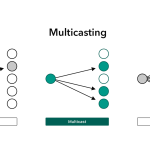Reservation protocols are the class of protocols in which the stations wishing to transmit data broadcast themselves before actual transmission. These protocols operate in the medium access control (MAC) layer and transport layer of the OSI model.
In these protocols, there is a contention period prior to transmission. In the contention period, each station broadcasts its desire for transmission. Once each station announces itself, one of them gets the desired network resources based upon any agreed criteria. Since each station has complete knowledge whether every other station wants to transmit or not before actual transmission, all possibilities of collisions are eliminated.
Examples of Reservation Protocols
The two prominent reservation protocols are −
- Bit – map Protocol that operates in the MAC layer
- Resource Reservation Protocol (RSVP) that operates in the transport layer
Bit – Map Protocol
In this protocol, the contention period is divided into N slots, where N is the total number of stations sharing the channel. If a station has a frame to send, it sets the corresponding bit in the slot.
Suppose that there are 10 stations. So the number of contention slots will be 10. If the stations 2, 3, 8 and 9 wish to transmit, they will set the corresponding slots to 1. Generally, the transmission is done in the order of the slot numbers. The process is shown in the following diagram:
Resource Reservation Protocol (RSVP)
RSVP is a transport layer protocol that is used to reserve resources in a computer network to get a different quality of services (QoS) while accessing Internet applications. It operates over Internet protocol (IP) and initiates resource reservations from the receiver’s end. It is used both for unicasting (sending data from one source to one destination) and multicasting (sending data simultaneously to a group of destination computers).


